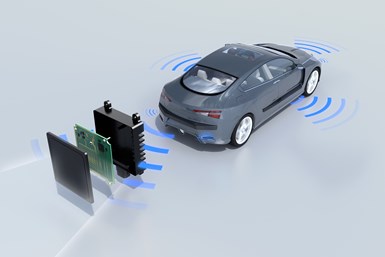BASF Touts New Radar Housing
Minimizing electromagnetic interference is key
BASF has developed a modified polybutylene terephthalate (PBT) specifically for use in radar housings.
Dubbed Ultradur RX, the new material is lighter and provides better electromagnetic protection than steel housings, according to the supplier. The dielectrically optimized plastic can be used in the rear housing cover or behind the printed circuit board of a sensor.
No Interference

(Image: BASF)
As the use of vehicle electronics increases, there is a greater risk of electromagnetic interference (EMI) within a car’s own architecture as well as between nearby vehicles and with smart traffic lights and other infrastructure.
The situation becomes even more challenging with advanced driver-assist and autonomous vehicle systems that rely on cameras, radar, lidar and other sensors to work properly. As a result, BASF envisions a growing market for materials such as Ultradur to help protect these devices against EMI.
RELATED CONTENT
-
Plastics: The Return of Body Panels?
A problem with plastics and steel structures is a difference in the coefficient of expansion. Some material modifications may ameliorate that problem.
-
Jeeps Modified for Moab
On Easter morning in Moab, Utah, when the population of that exceedingly-hard-to-get-to town in one of the most beautiful settings on Earth has more than doubled, some people won’t be hunting for Easter eggs, but will be trying to get a good look at one of the vehicles six that Jeep has prepared for real-life, fast-feedback from the assembled at the annual Easter Jeep Safari.
-
TPE Checks the Boxes
Plastics supplier KRAIBURG has developed a thermoplastic elastomer lineup—the VS/AD/HM series within the THERMOLAST K suite—that checks the boxes of scratch and abrasion resistance, chemical compatibility and UV stability.








